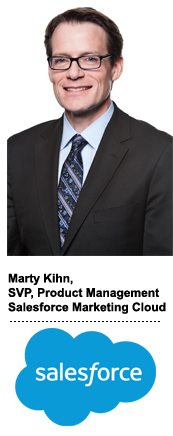
If a customer data platform (CDP) is a “fad,” then it’s a lasting one.
Salesforce is finally getting its messaging in order around the CDP.
Kind of. The details are a little sketchy right now. Salesforce isn’t officially announcing its CDP until June at its Connections conference in Chicago, there isn’t a tangible product yet and Salesforce demurred to say exactly when one will be generally available.
But Marty Kihn, SVP of product management for the Salesforce Marketing Cloud, tells AdExchanger that customers have been “loud and clear” in their requests for technology to better manage, analyze and act on their data.
“We think that the CDP as a category is an evolution of CRM – not a revolution – and CRM plays to our strengths,” said Kihn, who’s helping to lead the project and who helped define the space as a Gartner analyst. “What the market needs is for somebody to make a claim and build an enterprise-grade, reliable CDP.”
Salesforce’s messaging around CDPs has been inconsistent. Last year, Marketing Cloud chief Bob Stutz called it a “passing fad,” and Salesforce execs have often said that the company has the components of a CDP, if not a CDP by name.
An enterprise-grade CDP, in Salesforce’s view at least, is an end-to-end solution, something that combines analytics and predictive modeling with real-time activation managed alongside identity and consent. CDPs in the market often do one piece of that, but not the whole shebang, Kihn said, while Oracle and Adobe are mainly dancing around the CDP space and have yet to put a stake in the ground.
The CDP that Salesforce has in mind will be built from stuff it’s already got, including components from its DMP (formerly Krux); analytics and marketing intelligence from its Datorama acquisition last year; and identity management through Customer 360. MuleSoft, the API management platform Salesforce bought for $6.5 billion last March, also has a role to play, “but exactly how it will intersect with the CDP is TBD,” Kihn said.
Salesforce is also still figuring out exactly where the persistent customer record will live, which is a core component of any CDP. The Salesforce CDP will build on Customer 360, which helps Salesforce create a single identifier to use across its own cloud offerings, but more work will have to be done before it can serve as a true database.
The main newness that Salesforce will bring is a UI component that packages the whole thing together so that marketers can wrangle their data and run more personalized campaigns without having to get IT involved.
“We’re not necessarily talking about net new capabilities, but rather making an improvement,” Kihn said. “Personalization is a big word, but to me it mainly means cleaner data to do better analytics faster for a view of the customer that’s up to date so you can deliver a better experience – and that’s really all the marketer wants.”
A lot of CDP vendors have cropped up over the last few years to try and capitalize on that need. It’s become a bloated market in which hype is high and marketer confusion continues to reign. According to a recent report released by the Winterberry Group, fewer than one in five CDPs deserve to call themselves such.
“The CDP category is a category of refugees, pivots and renames, but that is characteristic of very early-stage mar tech categories,” Kihn said. “I would be very happy if the label disappeared and it just became CRM 5.0 or whatever version we’re up to.”
It doesn’t really matter, though, what the technology is called, he said. The trend is clear: Marketers want a single, reliable view of their customers, and it makes sense for Salesforce to try and hop to it.
“Generally speaking, the C in CRM is for ‘customer’ and the C in CDP is for ‘customer,’” Kihn said. “We’re focusing on CDPs as an extension of what we’re doing in CRM already – we’d be crazy if we were just trying to chase the vendor conversation.”
This post was syndicated from Ad Exchanger.


More Stories
MFA Sites Aren’t Going Anywhere Until There Are Incentives To End Them
TVNZ, AIA NZ, Together and NZME team up for new mental wellbeing series
Google Delays Cookie Deprecation For The Third Time